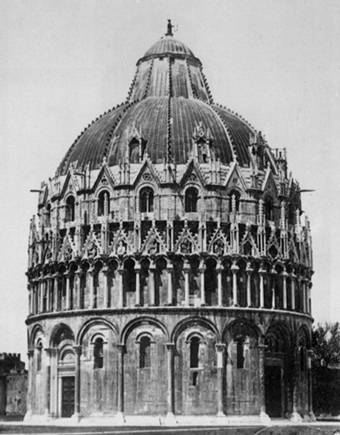
| The Symmetries of the Baptistery and the Leaning Tower of Pisa |
|---|
Scuola Normale Superiore, Pisa, ITALY
Institut de Physique Théorique, Louvain-la-Neuve, BELGIUM
 The round Leaning Tower of Pisa consists
of a massive ground floor with a blind arcade, six tiers of open
arches, and a smallish drum (tamburo). While the
symmetry of a circle is an infinite one, the number of architectural
elements of the tower reduce it to a finite one. The 15-fold
and 30-fold symmetry of the Leaning Tower is extremely rare,
if not unique. The Pisans of those times delighted in mathematical
relationships in building design: they knew what they were doing
when they constructed a pentadecagonal campanile.
The round Leaning Tower of Pisa consists
of a massive ground floor with a blind arcade, six tiers of open
arches, and a smallish drum (tamburo). While the
symmetry of a circle is an infinite one, the number of architectural
elements of the tower reduce it to a finite one. The 15-fold
and 30-fold symmetry of the Leaning Tower is extremely rare,
if not unique. The Pisans of those times delighted in mathematical
relationships in building design: they knew what they were doing
when they constructed a pentadecagonal campanile.
The Baptistery is not as harmonious as the Leaning Tower. It consists of four levels, and counting a garland of arches, there are five elements to be analyzed. The Romanesque ground floor consists of a blind arcade of 20 arches resting on 20 pilasters. The second level displays a striking "symmetry clash": a 12-fold symmetry. That this clash is not more manifest is due to the garland, which consists of 60 columns supporting 60 arches. Since
it stands in a consonant relation to the levels below and above as well as to the one it conceals. The third level returns to a 20-fold symmetry. The 12-fold symmetry of the cupola is again sharply at odds with the first and the third level.
Entering the Baptistery, one is captivated by the upward surge of the pillars and columns of the innermost space, crowned by the cupola. Everything in the interior is subordinated to the dominant 12-fold symmetry. Yet another "clash" is strikingly apparent: not counting the cupola, only two interior levels correspond to three exterior levels!
The symmetry clashes help reconstruct the history of the Baptistery construction. In 1185 the original plan for the exterior was replaced by that of Guidolotto, who, if not the designer of the Leaning Tower, was strongly influenced by it. His design involved the regular pentagon and pentadecagon, which had appeared for the first time in the construction of the Leaning Tower. But Guidolotto's capolavoro was not to everybody's liking. Circa 1221, the quarrels ended with the 12-fold symmetry triumphant. A third reversal, circa 1278, revived the icosagonal symmetry.
The consequence of the symmetry clashes was a continuous striving for reconciliation. Despite this, the Baptistery is overwhelming, especially in the light of a full moon.
|
David Speiser, "The Symmetries of the Baptistery and the Leaning Tower of Pisa", pp. 135-146 in Nexus: Architecture and Mathematics, ed. Kim Williams, Fucecchio (Florence): Edizioni dell'Erba, 1996. http://www.nexusjournal.com/conferences/N1996-Speiser.html |
|
|
|
|
